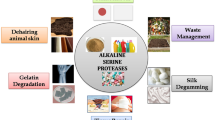Abstract
The enzyme from halophilic microorganisms often has unique properties such as organic-solvent-tolerance. In this study, a novel organic-solvent-tolerant α-amylase gene was cloned from the mild halophile Exiguobacterium sp. DAU5. The open reading frame (ORF) of the enzyme consisted of 1,545 bp and encoded 514 amino acids, the primary sequence revealed that it belongs to the glycoside hydrolase (GH) family 13. Sodium dodecyl sulfate-polyacrylamide gel electrophoresis (SDS-PAGE) showed an AmyH monomer of 57 kDa. The enzyme exhibited maximal activity at 40 °C in pH 8.5 glycine–NaOH buffer, and the activity was strongly inhibited by Zn2+, Cu2+, and Fe2+. The α-amylase AmyH exhibited high hydrolysis activity toward soluble starch, and the major hydrolysis products were maltose, maltotriose, and maltopentaose; the AmyH could not efficiently hydrolyze oligosaccharides smaller than maltoheptaose, nor could it act on the β-1,4 or α-1,6 glucosidic bonds in xylan or pullulan, respectively. In addition, the α-amylase exhibited better tolerance to organic solvents, as it was stable in the presence of dimethylsulfoxide (DMSO), methanol, ethanol, and acetone. Base on all of these results, the enzyme could be useful for practical application in the bakery industry and in biotechnological processes that occur in the presence of organic solvents.








Similar content being viewed by others
References
Vihinen, M., & Mäntsälä, P. (1989). Critical Reviews in Biochemistry and Molecular Biology, 24, 329–418.
Kandra, L. (2003). Journal of Molecular Structure: THEOCHEM, 7, 487–498.
Gupta, R., Gigras, P., Mohapatra, H., Goswami, V. K., & Chauhan, B. (2003). Process Biochemistry, 38, 1599–1616.
Pandey, A., Nigam, P., Soccol, C. R., Soccol, V. T., Singh, D., & Mohan, R. (2000). Biotechnology and Applied Biochemistry, 31, 135–152.
Saxena, R. K., Dutt, K., Agarwal, L., & Nayyar, P. (2007). Bioresource Technology, 98, 260–265.
Margesin, R., & Schinner, F. (2001). Extremophiles, 5, 73–83.
Ogino, H., & Ishikawa, H. (2001). Journal of Bioscience and Bioengineering, 91, 109–116.
Ogino, H., Miyamoto, K., Yasuda, M., Ishimi, K., & Ishikawa, H. (1999). Biochemical Engineering Journal, 4, 1–6.
Mevarech, M., Frolow, F., & Gloss, L. M. (2000). Biophysical Chemistry, 86, 155–164.
Dodia, M. S., Rawal, C. M., Bhimani, H. G., Joshi, R. H., Khare, S. K., & Singh, S. P. (2008). Journal of Industrial Microbiology and Biotechnology, 35(2), 121–132.
Pandey, S., & Singh, S. P. (2012). Applied Biochemistry and Biotechnology, 166(7), 1747–1757.
Shafiei, M., Ziaee, A. A., & Amoozegar, M. A. (2011). Journal of Industrial Microbiology and Biotechnology, 38(2), 275–281.
Li, X., & Yu, H. Y. (2012). FEMS Microbiology Letters, 329(2), 204–211.
Sambrook, J., & Rusell, D. W. (1989). Molecular Cloning. A Laboratory Manual. New York: Cold Spring Harbor.
Laemmli, U. K. (1970). Nature, 227, 680–685.
Bernfeld, P. (1951). Advances in Enzymology and Related Subjects of Biochemistry, 12, 379–428.
Lowry, O. N., & Rosebrough, A. F. (1951). Journal of Biological Chemistry, 193, 265–275.
Matsuura, Y., Kusunoki, M., Harada, W., & Kakudo, M. (1984). Journal of Biochemistry, 95, 697–702.
Bautista, V., Esclapez, J., & Pérez-Pomares, F. (2012). Extremophiles, 16(1), 147–159.
van der Maarel, M. J., van der Veen, B., Uitdehaag, J. C., Leemhuis, H., & Dijkhuizen, L. (2002). Journal of Biotechnology, 94(2), 137–155.
Reyes-Sosa, F. M., Molina-Heredia, F. P., & De la Rosa, M. A. (2010). Applied Microbiology and Biotechnology, 86(1), 131–141.
Takase, K. (1993). European Journal of Biochemistry, 211, 899–902.
De Mot, R., & Verachtert, H. (1987). European Journal of Biochemistry, 164, 643–654.
Yang, S. J., Lee, H. S., Park, C. S., Kim, Y. R., Moon, T. W., & Park, K. H. (2004). Applied and Environmental Microbiology, 70, 5988–5995.
Dey, S., & Agarwal, S. O. (1999). Indian Journal of Biochemistry & Biophysics, 36, 150–157.
Acknowledgment
This research was supported by Dong-A University Research Fund.
Author information
Authors and Affiliations
Corresponding author
Additional information
Jie Chang and Yong-Suk Lee contributed equally to this paper.
Rights and permissions
About this article
Cite this article
Chang, J., Lee, YS., Fang, SJ. et al. Recombinant Expression and Characterization of an Organic-Solvent-Tolerant α-Amylase from Exiguobacterium sp. DAU5. Appl Biochem Biotechnol 169, 1870–1883 (2013). https://doi.org/10.1007/s12010-013-0101-x
Received:
Accepted:
Published:
Issue Date:
DOI: https://doi.org/10.1007/s12010-013-0101-x




